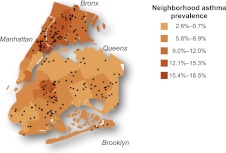FIGURE 1.
Map of New York City depicting study subjects’ places of residence overlaying neighborhood asthma prevalence. Neighborhood asthma prevalence was defined for 5-year-old school children as reported by the New York City Department of Health and Mental Hygiene.10 Participants were recruited from neighborhoods with lower (3%–9%) or higher (11%–18%) neighborhood asthma prevalence.

